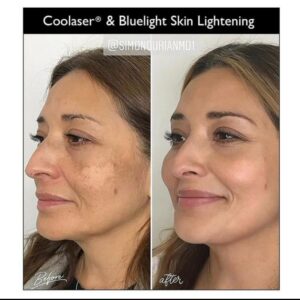In this article, we will explore melasma, a challenging skin condition that can impact both your complexion and confidence. Melasma-related skin discoloration characterized by gray-brown patches often leads to frustration. Our aim is to provide you with knowledge and practical approaches to help you achieve more radiant skin. Throughout this exploration, keep in mind that understanding melasma and its treatment is the step towards transforming your skin and embracing the beautiful complexion you deserve. Contact us today to learn more about treatment options.
What are the factors responsible for causing melasma and its associated skin discoloration?
Melasma and its associated skin discoloration have interconnected causes. Hormonal changes play a role in triggering melasma. There are factors that can contribute to changes in skin pigmentation. These include:
- Pregnancy: The use of contraceptives and hormone replacement therapy (HRT).
- Exposure to sunlight Plays a role as UV) radiation stimulates pigment-producing cells called melanocytes, resulting in increased production of melanin and subsequent skin discoloration.
- Genetics: Seems to play a part as melasma often runs in families suggesting a component.
Certain areas of the skin that are particularly sensitive to changes tend to be more prone to melasma. These areas typically include the cheeks, forehead, nose, chin, and upper lip region. Other contributing factors may include thyroid disorders and specific medications like antiseizure drugs or certain cosmetics. Understanding these causes is essential for developing strategies aimed at managing and treating melasma-related skin discoloration.

What are the available treatment options for addressing skin discoloration caused by melasma?
There are treatment options for melasma-related skin discoloration:
- 1. Skin lightening agents: These products inhibit production and enhance skin cell turnover.
- 2. Chemical peels: They remove the layer of pigmented skin to encourage skin growth.
- 3. Laser therapy: This method targets melanin while stimulating collagen production.
- 4. Microneedling: It promotes collagen production and reduces pigmentation through controlled micro-injuries.
- 6. Sun protection: Essential to prevent pigmentation issues.
- The effectiveness of these treatments varies, so combining therapies is often recommended. It is important to consult with a dermatologist for an approach to your skin concerns.
Are these treatments effective?
When it comes to melasma and skin discoloration, a complete cure is difficult to achieve. There are ways to manage and improve the condition. Treatment mainly focuses on reducing pigmentation and preventing discoloration through lifestyle changes and consistent sun protection.
In conclusion, while melasma presents its challenges there are numerous strategies that can help you achieve a clearer and more radiant complexion. Remember that successful management and improvement are possible through treatments, lifestyle adjustments, and sun protection. Embrace the path towards beautiful skin and let your confidence shine through with Dr. Simon Ourian.